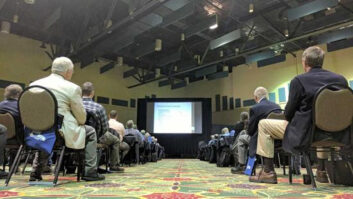WICR(FM) “The Diamond” 88.7 is a public radio station owned by the board of trustees of the University of Indianapolis. It is operated by university students, faculty and staff with programming from Classical Music Indy, American Public Media, and other outside, independent producers.
In 1962, WICR was broadcasting with only 10 Watts of power. Throughout the years, it has received grants to increase its effective radiated power, and today it’s a licensed non-commercial full-power Class B station at 5,000 Watts. The combination of 5,000 Watts of power and an antenna height of nearly 700 feet give WICR coverage area equivalent to that of a 30,000-Watt FM station.

The building housing the station was built several decades ago; WICR resides on the third floor of a 50,000 square foot expansion completed in 2005.
The WICR engineering staff designed the facility, working with the university’s physical plant. Current General Manager Scott Uecker (who is also the former chief engineer) and Russ Maloney, who was the director of engineering at the time, contributed to the design of the stations and studios.
WICR also received input from students, alumni working professionally in the field, and some professionals in the local engineering community, most notably the late Don Payne.
All were instrumental in the build-out.
TECH SPECS
The studio furniture in the radio facility is all custom-built by local contractor Mike Grzelak, local carpenter in Indianapolis. The university also recently updated the TV control room and installed new studio furniture from Forecast Consoles.

WICR radio and television facilities are both driven by Axia. The on-air studios are equipped with Axia Fusion consoles; Element consoles round out the rest of the studios, including the television control room.
WICR has a total of five studios that are used for on-air purposes: three air studios, a talk studio and a news studio. Each HD channel has its own air studio along with the FM. There are three production studios in the facility, and the HD-2 air studio, since it is usually unmanned, can double as a production studio; if an on-air studio fails, any production studio can be put on the air with the click of a few buttons through Axia.
With Axia, the routing is simple and mainly software based. All routing controls are done with a computer and a web browser. The analog and mic nodes take the different inputs and outputs to and from recording devices and sound cards via an Ethernet cable.
WICR chose the StudioHub Adapters to hookup gear to the network. These adapters work with several types of connections, going from RJ45 to XLR, 1/4-inch, 1/8-inch, RCA, etc.
The engineering staff is in the process of documenting every single input and output in the facility.
As daunting as it sounds, the binder that they are using to put everything together has come in handy on several occasions.
Currently, they have maxed out capacity on two Cisco 24 port switches — just on the radio side. The television facility is connected to the radio side via a trunk cable to the TV Cisco switch.
LEARNING
WICR is using Audio Vault for its automation systems, as well as other equipment like the Sage Digital ENDEC, both VoxPro and 360 Systems Shortcut. They use these in the FM/HD-1 and HD-3 studios to give every student the experience using various systems to prepare them for the real world.

WICR is also teaching students how to use the Telos Assistant Producer call screening software during its talk shows. They have access to the Associated Press for its 5 p.m. newscast that airs Monday through Friday.
The students stay busy with two Comrex Access Portable units that are used for remote broadcasts. The station airs radio broadcasts of all the university’s football and basketball home and away games. They have also aired softball and baseball games on its HD-3 channel, unless the teams are in collegiate tournament play, at which point those games air on HD-1.
Program audio from the main FM/HD-1 studio passes through Nielsen encoders and hits the Omnia-6hd from the processor in the engineering room. Continuing through the air chain, program audio then feeds both the Broadcast Electronics XPi 10esp exporter and a Moseley Starlink, which is the first half of a back-to-back radio shot out to the tower site. (WICR uses a second STL frequency from the intermediate relay point out to the transmitter site. The back-to-back path is roughly 18 miles long.)

The HD-2 and HD-3 channels pass through the encoders and then go into a Broadcast Electronics IDi 40 importer, before joining the exporter in the air chain. Once the signal reaches the tower site it goes into a BE FXI 250 exciter, which drives the primary transmitter, a BE FMi 703. A BE FMi 201 is ready to go as a backup transmitter as well.
WICR also has two Barix boxes that serve as a backup audio feed for its main channel. Using its remote control system, if the exciter detects a drop in signal from the Moseley Starlink SL9003Q, it will automatically switch to the Barix. In addition, WICR has an ISDN from its studio to tower site which serves as an additional redundancy. WICR strives to stay on the air by any means.
AudioVault from Broadcast Electronics is WICR’s on-air playout system; online streaming is supported by WideOrbit. There are various ways you can listen to WICR online and on mobile devices. The WICR app is available from the Google Play Store or iTunes; in addition, WICR also sends AAC and MP3 streams to TuneIn, iHeartRadio and iTunes Radio.
WICR provides students a wealth of opportunities to learn valuable skills needed in radio broadcasting and allied industries.

These opportunities range from on-air work to behind-the-scenes roles in production, programming, news, sports, promotions, sales and engineering. WICR has a student management team that oversees the staff and runs the station.
The broadcast technician usually runs department meetings and during that time will train the students on proper termination of cables, connector types, soldering, proper usage of the Access remote gear, Axia systems, AudioVault administration and RF.
During the summer months, the director of engineering trains the student broadcast technician in the same areas, so that they are ready to go for the start of the school year. The phone number and email addresses of the broadcast technician are also entered into the emergency call list for off-air situations. This gives the student real world experience.
Still, the department works together as a team to fix whatever problems exist and always tries to involve everyone in the solution.
Scott Uecker and Joe Boehnlein, WICR director of engineering, contributed to this article.












